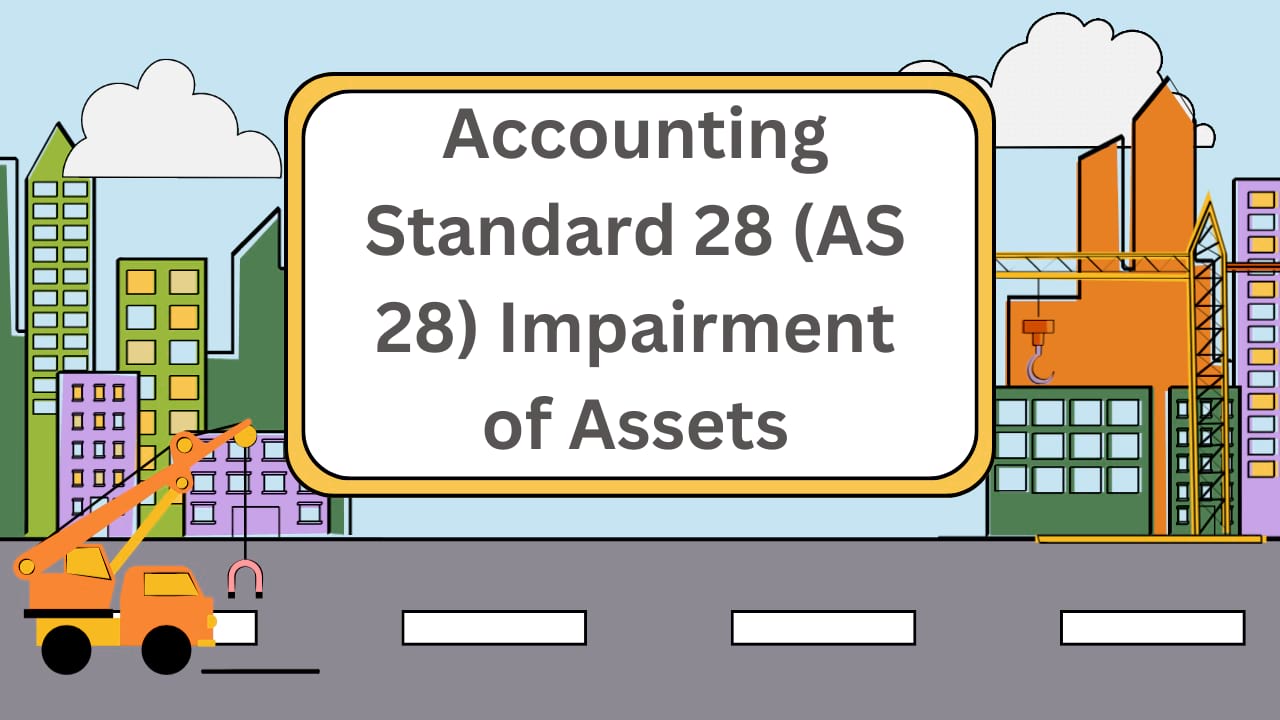Accounting Standard 28 Impairment of Assets: The objective of AS 28 is to prescribe the procedures that an enterprise applies to ensure that its assets are carried at no more than their recoverable amount. The asset is described as impaired if its carrying amount exceeds the amount to be recovered through the use or sale of the asset and AS 28 requires the enterprise to recognize an impairment loss in such cases. It should be noted that AS 28 deals with impairment of all assets unless specifically excluded from the scope of the Standard.
If you like this article then please like us on Facebook so that you can get our updates in the future ……….and subscribe to our mailing list ” freely “
Accounting Standard 28 Impairment of Assets
Impairment Loss (Expensed in P/L) = Carrying Amount less Recoverable Amount
Applicability of AS 28
AS – 28 should be applied in accounting for the impairment of all assets except the following :
- Inventories (As – 2)
- Assets arising from construction contracts (AS – 7)
- Financial assets including investments that are covered by AS – 13.
- Deferred tax assets. (AS – 22).
Terms to be known for Accounting Standard 28
1. Recoverable amount
- It is the higher of an asset’s net selling price and its value in use.
- Value in use means the present value of estimated future cash flows.
2. Carrying amount :
Carrying amount means the book value of an asset after depreciation and after any revaluation that is carried by an enterprise in its balance sheet. Must Check How to Finalize Balance Sheet.
| Carrying Amount | Recoverable Amount (Higher of) |
| Net Selling PriceEstimated Sales proceeds less costs of disposal | Value in use- Present value of estimated future cash flows expected to arise from the continuing use of an asset and from its disposal at the end of its useful life |
SMCs and non-company SMEs falling in Level II and Level III are allowed to measure the ‘value in use’ on the basis of reasonable estimate thereof instead of using the present value technique.
3. Impairment loss :
An impairment loss is the amount by which the carrying amount of an asset exceeds its recoverable amount.
4. Cash generating units :
A cash-generating unit is the smallest identifiable group of assets that generates cash inflows from continuing use that are largely independent of the cash inflows from other assets or groups of assets.
Taxation point of view
- Impairment is not considered for the calculation of taxable income
- But depreciation is considered and this is the major difference between Depreciation and impairment.
Quick Links
Indicators of impairment
An enterprise should assess at each balance sheet date whether there is any indication that an asset may be impaired. You may also like Subsidiary Books.
A. Externally :
- Significant Decline in the market value of the asset other than due to natural wear and tear.
- Significant adverse changes have taken place in the technological, market, economic, or legal environment.
- An increase in interest rates on investments would increase discounting rates which affect the value in use of assets.
- The carrying amount of net assets is more than the market capitalization of the entity.
B. Internally :
- Significant internal developments have happened affecting the value of the asset, eg., plans to restructure, because of what some assets become useless.
- Technological and physical obsolescence.
- internal evidence suggests that the economic performance of the asset is worse than expected.
- Impairment loss of a revalued asset should be treated as a revaluation decrease under AS 10.
- When the amount estimated for an impairment loss is greater than the carrying amount of the asset to which it relates, an enterprise should recognize a liability if, and only if, that is required by another Accounting Standard.
- After the recognition of an impairment loss, the depreciation (amortization) charge for the asset should be adjusted in future periods to allocate the asset’s revised carrying amount, less its residual value (if any), on a systematic basis over its remaining useful life.
- If there is an indication that an asset may be impaired, the recoverable amount shall be estimated for the individual asset.
- If it is not possible to estimate the recoverable amount of the individual asset, the entity shall determine the recoverable amount of the cash-generating unit to which the asset belongs (the asset’s cash-generating unit).
A cash-generating unit is the smallest identifiable group of assets that generates cash inflows from continuing use that are largely independent of the cash inflows from other assets or groups of assets.
An impairment loss should be recognized for a cash-generating unit, if and only if, its recoverable amount is less than its carrying amount.
Treatment of impairment loss :
- Assets not revalued – profit a/c
- Assets revalued-recognised against revaluation reserve
- Related deferred tax asset/liability determined.
The top-down approach and bottom-up approach :
1. Bottom-up approach:
If the assets are not capable of being individually identified of impairment at their level then in such case, identify the Cash generating unit to which this asset belongs. After identifying compare the recoverable value of the whole unit with the carrying value of this particular asset and then decide on its impairment.
2. Top-down approach :
As per this, we are required to test the assets with indefinite lives at the lowest level of the cash-generating unit level under which it is and not at the level of the whole company or department.
Reversal of impairment loss :
1. An impairment loss recognized earlier may be reversed if there are any indicators as given below :
External indicators:
- Assets market value has increased
- Significant changes have occurred that favorably affect the asset’s value.
- Market interest rates have come down.
Internal indicators:
- Significant favorable changes have taken place within the entity which indicates that the asset may be in good use.
- Internal evidence indicates that the asset may perform better than expected.
Must Check Objectives of Accounting.
Reversal of an Impairment Loss
- An enterprise should assess at each balance sheet date whether there is any indication that an impairment loss recognized for an asset in prior accounting periods may no longer exist or may have decreased. If any such indication exists, the enterprise should estimate the recoverable amount of that asset. The carrying amount of the asset should be increased to its recoverable amount as a reversal of impairment loss.
- The increased carrying amount of an asset due to a reversal of an impairment loss should not exceed the carrying amount that would have been determined (net of amortization or depreciation) had no impairment loss has been recognized for the asset in prior accounting periods.
- A reversal of an impairment loss for an asset should be recognized as income immediately in the Statement of Profit and Loss unless the asset is carried at revalued amount in accordance with another Accounting Standard in which case any reversal of an impairment loss on a revalued asset should be treated as a revaluation increase under that Accounting Standard.
Disclosure under Accounting Standard 28
- Amount of impairment loss recognized in statement of profit and loss
- Reversal of impairment recognized in P/L statement
- Impairment loss is taken directly to revaluation reserves.
- Reversal of impairment taken to revaluation.
In case of significant impairment or reversal, enterprise should disclose Events and circumstances because of which it happened.
Individual assets –nature of the assets
Cash generating units.
Whether the recoverable amount is the net selling price or value in use and the discount rate used to get the present value of future cash flows that will be arriving since its disposal.







